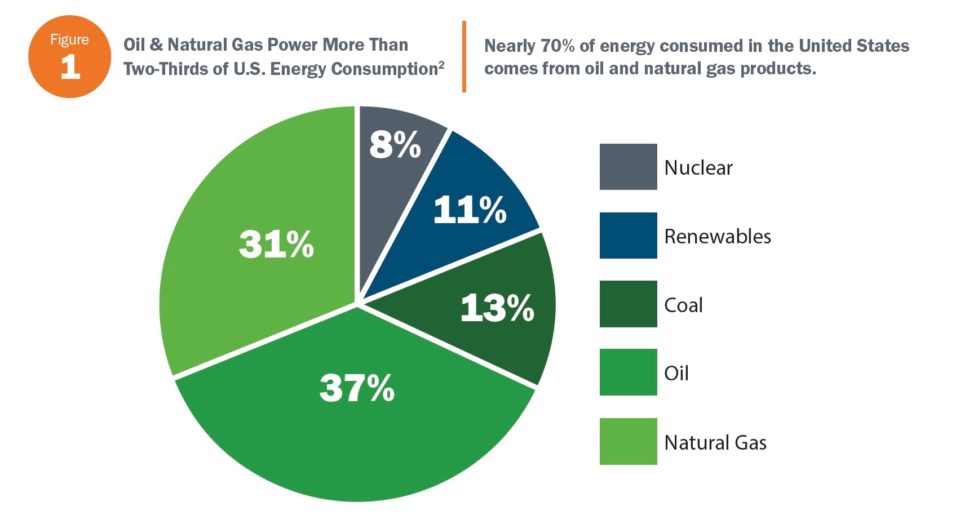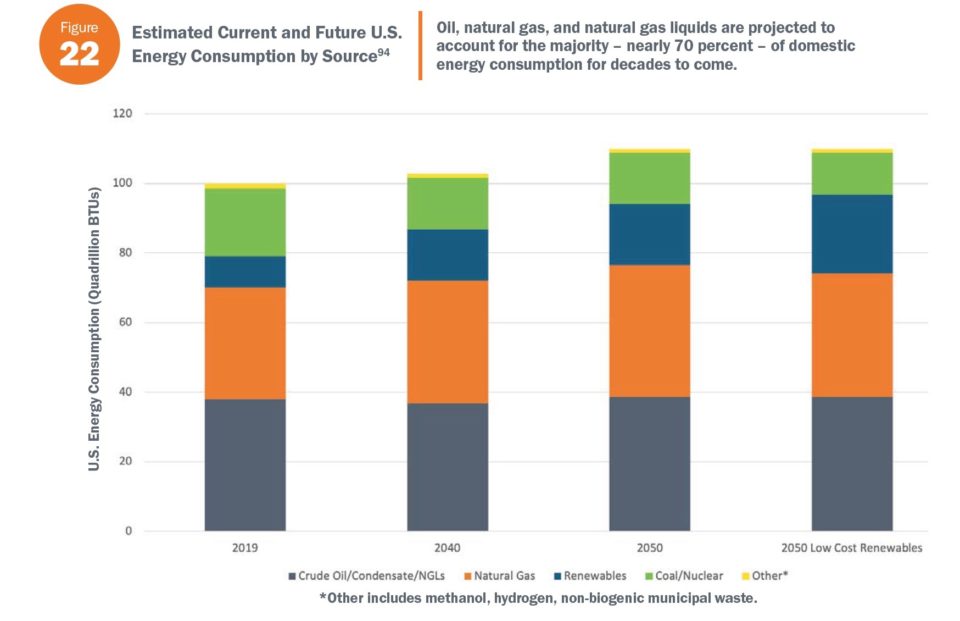6 Things to Know About New Department of Energy Report on Importance of Oil and Natural Gas
Much has changed since the U.S. Department of Energy (DOE) released a 1999 report emphasizing the importance of oil and natural gas to the United States. But one thing has remained the same in the 21 years since: A general lack of knowledge about the prominent role of oil and natural gas in our country’s present and future prosperity remains.
It is with the latter reality in mind the DOE recently updated and re-released that report. Here are six things to know.
#1: The DOE Expects O&G’s Share of the US Energy Mix to Stay the Same Through 2040
The report notes that oil and natural gas’ share of the U.S. energy mix is currently near 70 percent, as the following graphic illustrates.

And despite all the hoopla about the “green” energy transition, the DOE expects oil and gas’ share of the energy mix to remain at nearly 70 percent through at least 2040.

As the report notes:
“Even after accounting for the steady growth of renewables, according to the EIA, oil, natural gas, and natural gas liquids are projected to account for the majority – nearly 70 percent – of domestic energy consumption two decades from now.”
This completely debunks the “peak oil demand” narrative currently being pushed by “Keep It In the Ground” groups. For example, the Sierra Club recently published a piece headlined, “The End of Oil Is Near: The Pandemic May Send the Petroleum Industry to the Grave.” There are many reasons for the divide between the reality highlighted in the DOE report and the rhetoric pushed by the Sierra Club.
The next fact pulled from the DOE report is a prime example.
#2: Oil and Gas Are More Than Just Fuel
The DOE report emphasizes the fact that oil and natural gas are used for much more than combustible fuel for transportation, power generation and heating. Many Americans remain unaware that oil and natural gas liquids are essential feedstocks for countless products that make our high standard of living possible. From the report:
“Hydrocarbons like ethane are the core ingredient in plastics, and are essential to modern healthcare, agriculture, the automotive industry, construction products, consumer products, and even renewable energy. Ethane is a liquid hydrocarbon removed from natural gas during post-production processing. While a relatively small portion of liquid hydrocarbons (about seven percent) are used to produce non-energy products, these products’ omnipresence in our daily lives bears highlighting. We cannot live our 21st century lives without them.”

More than 6,000 everyday products are petroleum-based and 31 percent of U.S. petroleum use occurs outside of the transportation sector.
#3: Renewables Need Oil and Gas
Among the list of thousands of petroleum-based producers are components of renewable energy infrastructure. Petrochemicals are required to manufacture solar panels, wind turbines, batteries, thermal insulation and electric vehicles.
With those facts in mind, the DOE report notes that we would still need significant quantities of oil and natural gas to accomplish the titanic transition to 100 percent renewable electricity generation that so many “Keep It In the Ground” groups advocate for. As the report notes:
“Even efforts to reduce our reliance on fossil fuels still require that we use hydrocarbons – derived from oil and natural gas – to create and maintain the products and technologies that make these alternative energy sources reliable and economically possible.”
“Lightweight, durable plastics produced with oil and natural gas are used by most wind turbine and solar panel manufacturers.”
The report also emphasizes that because wind and solar are intermittent energy sources. backup natural gas power generation will remain necessary for the foreseeable future. From the report:
“While the share of power produced by renewable energy sources like solar and wind is expected to grow, these sources are ‘intermittent’ – wind energy fluctuates with the wind intensity and solar energy fluctuates with cloud cover and nighttime darkness – so there has to be a reliable, secure means to provide continuous electricity to consumers. The larger the contribution of renewables to the electric power grid, the bigger this challenge can be.”
“An effective solution is installation of fast-ramp-up natural gas power plants, which can be switched into the power generation system quickly whenever renewable generation slips. Such plants are capable of reaching full power outputs of hundreds of megawatts in less than 30 minutes and can be scaled back quickly when the wind picks up or the sun comes out. This role for natural gas will continue until low-cost, environmentally sustainable, large-scale power grid batteries capable of storing solar or wind-generated energy and discharging it instantaneously are available.”
#4: Oil and Gas Are Essential to Modern Healthcare and Agriculture
Some might argue that many of the petroleum products and modern advances made possible by oil and natural gas emphasized above might be viewed as superficial luxury items that we can live without if need be. But the report highlights two examples of absolutely essential industries that have been greatly enhanced by oil and natural gas: healthcare and agriculture.
The report notes that oil and natural gas have revolutionized modern agriculture, helping feed an exploding global population. In addition to fueling modern agricultural machinery, the report notes:
“Natural gas is also a key ingredient for chemical fertilizers, helping increase crop production and yield per acre planted, and powering many important operations on the farm like crop drying.”
The report notes that the ongoing pandemic has placed emphasis on the importance of fundamental healthcare and the role of oil and natural gas in it.
“The global economic disruption associated with the 2020 COVID-19 pandemic has highlighted the complicated relationship between our energy supply, society’s economic strength, and humanity’s physical health. Supplies of oil and natural gas are critical to all of the sectors of society involved in fighting the virus – fueling first responder ambulances, powering hospitals, and providing raw materials for lifesaving drugs and the personal protective equipment needed by caregivers.”
It is largely because of advances in healthcare and agriculture – both made possible by oil and natural gas – that extreme poverty recently dropped below 10 percent for the first time in recorded history. Access to food, healthcare and modern energy have made life easier, and they are all made possible by oil and natural gas.
#5: Increased Oil and Gas Production Has Made the United States Energy Independent
The report notes that the United States has reversed its position from that of energy dependence to energy independence thanks to increased oil and natural gas production over the past decade-plus.
“Dramatic increases in domestic oil and natural gas production enabled the United States to move from being an energy importer to being a net energy exporter. This shift means we are no longer dependent on other countries to meet our domestic energy needs. As a growing supplier of natural gas to global markets, the United States is now in a position to help its allies worldwide power their economies.”
The United States was the world’s largest oil importer in 2008. As oil and natural gas liquids production increased 148 percent from 2007 to 2019, net petroleum imports decreased 95 percent. Just 13 years removed from being the world’s biggest energy importer, America is now on a trajectory to completely wipe out an energy trade deficit that peaked at $321 billion in 2011. Much to the chagrin of the hostile nations we once relied heavily on to meet our energy needs, what was once a glaring national weakness is now a strength, and our geopolitical position is as strong as its been in decades as a result.
#6: The Oil and Gas Industry Provides Hundreds of Thousands of Well-Paying Jobs and Boosts the Economy
The DOE report notes that the U.S. oil and natural gas industry provides quantity and quality when it comes to jobs. From the report:
“The domestic oil and natural gas extraction industry supports 896,000 jobs (as of the end of 2019), including both direct and indirect jobs. This consists of 158,000 direct jobs and an estimated 738,000 indirect jobs, such as service and supply jobs, as well as induced jobs. The Economic Policy Institute reports that the oil and natural gas extraction industry has one of the highest indirect job employment multipliers, where one direct job leads to an additional 5.43 indirect jobs.
“Last year, the average direct job in the oil and natural gas extraction industry had an annual average wage of $112,000, more than double the annual average wage of $51,000 for the private sector. … Non-supervisory direct jobs average annual wage of $88,000, about 70 percent higher than the average private sector wage.”
The loss of these jobs as a result of “Keep It In the Ground” policies would prove devastating to our economy and would only lead to increased imports from oftentimes hostile nations to meet our energy needs.
The report also notes that strong U.S. oil and natural gas production in recent years has saved Americans billions by keeping energy costs affordable. From the report:
“The lower oil and natural gas prices resulting from increased domestic oil and natural gas production provided $203 billion annual savings to U.S. consumers – equal to $2,500 per year for a family of four.”
Conclusion
As the DOE report notes, “… A seamless transition to a lower carbon future will depend on a steady supply of hydrocarbons to minimize economic disruption.” This is a fact that too few Americans are aware of. As the report clearly illustrates, it remains essential for the United States to produce as much as the oil and natural gas here as possible moving forward.
